Do you like to spend time in nature at night and observe the surroundings? Then you need a night vision monocular head mount with you. These monoculars are a part of the revolutionized models that consist of many fresh features and details that help people get bright views no matter how dark the surroundings are.
The fact that they can be mounted on the head makes it easier to view while at the same time doing something else with the free hands. For this reason, they are utilized for different purposes, starting from professional surveillance and hunting up to military activities.
Yet some users find it hard to find the right night vision monocular with a head mount for them. If you’re one of them, you’ve come to the right place as here we’ll go over all key things you should know.
Top 3 Picks: Night Vision Monocular Head Mount
BEST VALUE
Vbestlife Digital Night Vision Monocular Device PVS-14 for Helmet
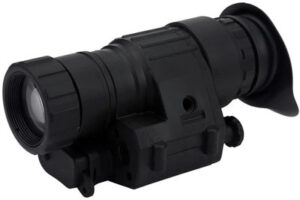
BEST OVERALL
Yukon YK24025 NVMT 1×24 Night Vision Monocular
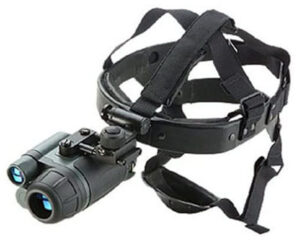
BEST PRICE
GFYL Head-Mounted HD Night Vision Monocular

Reviews & Comparison
Not all users have the same tastes and not all monoculars with a head mount are the same. Some have better views in the dark while others are lightweight and comfortable on the head. Therefore, potential buyers should carefully examine their budget and possibilities and see which features they can get for the money.
In the following reviews, we compiled something from everything to give you an idea of what is offered on the market.

Firefield Spartan 3×42 Night Vision Monocular
It’s true that this is a modern monocular but it still doesn’t let go of the traditional practicality. Its digital capabilities make it versatile and usable in various situations. And the body made of rubber keeps it safe when the weather conditions are changing. Thanks to it, it’s waterproof and durable.
As for the views, the completely multi-coated lenses and the incorporated infrared illuminator expands the viewing area and brightens the surroundings. Not to mention that the magnification is enough for observing both in a short- and long-distance.
Despite this, though, users report certain downsides that have to do with the robust construction and the field of view that’s limited.

Yukon YK24025 NVMT 1×24 Night Vision Monocular
Yukon has made this night vision monocular popular for those that want to mount their monoculars on a helmet. And indeed, the model works just fine in this arrangement. The black color of the monocular’s construction gives it elegance and it blends perfectly in the dark surroundings it’s usually used in. Also, it’s pretty light so users don’t have to worry about it weighing and slowing them down.
However, some customers weren’t entirely satisfied with the low magnification powers. Still, let’s check out some of the highlight specifications incorporated in the model.

Vabogu Monocular Telescope
This monocular can be utilized both during the day when it provides high-resolution and vivid visuals and during the night when it displays black-and-white visuals. Thanks to the infrared illuminator, there is bigger visibility in the latter situation.
When it comes to the design, it’s very ergonomic, weather-resistant, and long-lasting. What’s more, the model is light and mobile. Due to the full coatings of the lens, contrasts of the colors, as well as brightness, are achieved. The field of view is wide enough to assess the close environment.
It’s worth noting that a few buyers weren’t big fans of the magnification. According to them, when the monocular is mounted on the head, the internal screen wasn’t lining up exactly with the eyes.
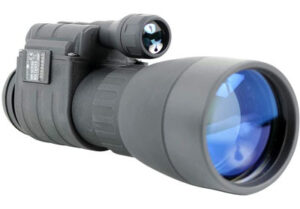
Sightmark Ghost Hunter 5×60 Night Vision Monocular
Thanks to its compact design and lightness, users don’t have a hard time transporting the model as well as storing it. It’s long-lasting, too, and made of polymer. With that being said, the monocular delivers bright visuals and up-close observations thanks to the focus capabilities. The socket, which has a size of a quarter of an inch, is suitable for mounting on the head, on a tripod, or for similar accessories.
A slight thing that can be worked on is that there is no variable zoom. Additionally, it delivers a peak performance during nighttime and it won’t be as effective during the day.
Now, let’s move onto some of the model’s features.
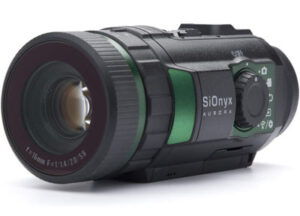
SiOnyx Aurora Infrared Night Vision Monocular
One of the most attractive features of the model is the streaming option thanks to a special application developed by the brand. Moreover, the monocular can be synced with a smart device such as a smartphone and video streaming can begin.
Due to the infrared technology, which is built in the model, users can operate with the monocular while hunting, surveilling, boating, and even utilize it for military activities. The fact that it’s waterproof contributes to that, too. Users can submerge it in water to three feet for half an hour, and the brand claims that the monocular will still be fully operational.
As a small con, a couple of customers mention the smaller-than-usual screen as well as a shorter focal length. If you’re interested to find out more, take a look at the following specifications.
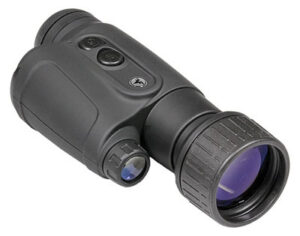
Firefield Nightfall 5×50 Night Vision Monocular
With satisfying magnification capabilities as well as a big lens, users can see plenty of what lies before them and in great detail, too.
Further, the construction is durable and eye-catching. Plus, it doesn’t take up much space and it’s easy to carry around. The system is quite user-friendly, so even first-time users won’t have trouble finding their way around with it.
The infrared illuminator for night-time observations is completely built-in. Also, together with the night vision monocular, buyers get a case for transportation as well as a special cloth for the lens.
However, some customers didn’t like that the model is just for night usage only. And the field of view is slightly narrower when compared to similar models.
Take a glance at specifications and features that follow next.

BNISE 8×40 Infrared Night Vision Monocular
Besides nighttime usage, the model works in the day time, too. As for the night-time observations, users can see up to two hundred meters in complete darkness. Understandably, the model is functional in low-light conditions. Having said that, the monocular can be connected to a computer with a USB cable and there’s an audio/video output as well. The slot for head mounting and tripod mounting has a standard size. Apart from simple observation, users have an opportunity to take pictures and capture videos.
On the other hand, some users note that the LCD display doesn’t have a very high resolution. Overall, the model is very affordable, so the quality of the build and the performance is great for the money.
We’ll dedicate the next section to the specifications of BNISE’s night vision monocular.

GFYL Head-Mounted HD Night Vision Monocular
The toughness of the design is what really stands out in the case of this night vision monocular. The construction is metal and exceedingly durable. Plus, it has a no-slip feature so that users can hold it more firmly in their hands. It absorbs shocks, too. Still, it keeps its weight in the normal range, which enables more mobility.
The wide field of view ensures the observation of moving subjects. With it, users can see what surrounds them and observe details thanks to the multiple coatings of the lens.
Something that can be improved, according to buyers, is the lower magnification. What’s more, the specifications and features are as follows.
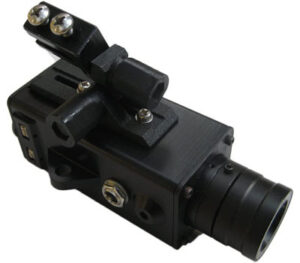
Electric Magic E&M SEQ Separating Night Vision Monocular
The black design gives the device both a retro and a modern look. It’s pretty lightweight, as well. When operating with it, it’s best to do so in low-light conditions. That is enabled due to the infrared capabilities of the model. What’s more, the model is resistant to harsh external conditions and is dustproof. With the purchase, people also receive a charger as well as a few handy accessories.
It’s worth mentioning that a few users weren’t entirely satisfied with the zooming option in very dark surroundings. So, it’s time to move onto the model’s features.

Carson MiniAura Digital Night Vision Monocular
Just as its name suggests, this Carson model goes fully digital with night vision visuals that are black and white. What’s more, their great resolution is made possible due to the infrared capabilities. The infrared features are easily modifiable with just a click of a button.
Some customers claim that water resistance isn’t one of its assets. Here are some specifications as well as features to consider.
Also see: Best cheapest night vision goggles
Guide for Buyers
Everyone has his/her reasons for buying a night vision monocular with a head mount. As equipment that lets you observe faraway objects up close, monoculars have multiple perks. They’re usually smaller than binoculars yet users can perfectly well see what surrounds them far and wide. They’re utilized with just one eye, so the other one is free to observe the close environment and supplement the viewing experience. With that being said, let’s take a closer look at some of the highlight features that one should watch out for when looking for the next night vision monocular to buy.
Head Mount
A monocular’s ability to be mounted on the helmet of the user is a very popular feature that lots of users are looking for in the models they’re interested in purchasing. One of the reasons is that this frees up the hands so that they can be occupied with something else other than holding a monocular such as hunting, surveillance, hiking, and more.
Infrared
When someone mentions the words ‘night vision’, the infrared features are close by. Infrared has been associated with monoculars that are capable of delivering quality visuals during nighttime as well as in surroundings with a low amount of light.
That’s why many models have an infrared (or IR) illuminator. For those who aren’t exactly familiar with how it works, the mechanism is similar to the one of a flashlight, but not quite. It’s important that light is emitted in the dark, so the user can see clearly what lies in front of them.
Another connected feature is the switchable infrared capabilities. With this, the infrared is easily modifiable. Users, who plan to use their night vision monoculars during the day, can simply turn the infrared off. And the model will act as a regular digital one despite it being a night vision one as well.
Field of View
This is one of the most talked-about specifications when it comes to monoculars or optics, in general. Moreover, it’s often measured in either angles or feet (when it’s measured in feet, it’s usually ‘x feet at a thousand yards’). It represents how wide you’re able to see in front of you when looking through the lens of the monocular.
Experts advise people to go for a larger field of view if you’re observing a subject that’s quick to move. This is especially valid while hunting or surveilling.
What’s more, a trade-off usually exists between the field of view and the magnification of the model. A larger field of view like in the example above, asks for lower magnification powers. On the contrary, if you zoom in a lot (higher magnification), the field of view or the width of the environment around you will significantly shrink as a result of that.
Price
How much a night vision monocular is going to cost your budget is almost as important as determining what you’re going to use it for.
A unified price for all monoculars doesn’t exist. In turn, it’s determined by the brand, the quality of the product, its performance, the generation it belongs in, and more. That’s why users should be informed about the price tiers and what kind of night vision monocular with head mounted they’ll likely get for a particular sum of money.
Let’s say upfront that the newest and state-of-the-art monoculars are going to cost you the most when you compare them with others. And we’re talking about a sum north of three hundred dollars. Then, there are some models that are in the middle range and then follow the cheapest models, which can be found for less than two hundred bucks.
Generally speaking, if a model has a ton of features, it’s highly likely that it’s going to have a high number written on the price tag. On the other hand, it’s safe to say that monoculars as a whole are less expensive than other night vision gear because they’re more compact and are smaller.
Resolution of Visuals
By the quality of an image, we understand how much detail the image displays. The more clearly you see the more quality the image is. Furthermore, the resolution becomes even more important when the night vision monocular has the capability to take pictures and record videos in the dark. That’s because it will determine the quality of the picture or the video that can later be stored on an SD card and shared with other devices.
Of course, a high resolution is always desired, but users should have in mind that that may cost them a bit more than they’ve planned. With that being said, the resolution of monoculars is often measured in line pairs per millimeter.
Resistance to Weather
Anything can happen when the user is outside with the night vision monocular. By that, we mean that pouring rain is a frequent event when you’re out hunting or hiking or doing some other activity. And when that occurs, the monocular will be ruined if its whole design and its construction aren’t weather-resistant.
Besides that, monocular brands tend to make their products more and more weatherproof as well as fog proof. Also, preventing dust, debris, and other small particles from coming into the lens system is another addition that can significantly protect the model and keep its great performance. It goes without saying that this increases the durability and enables the user to utilize the monocular longer.
Maintenance
The purchase of a night vision monocular that suits your needs isn’t the end of your journey with the product. It’s just the beginning. And the proper way of maintaining it is crucial for its durability and effective performance. When we’re talking about maintenance, we, usually, mean proper cleaning, storage, as well as utilization.
For starters, every user should carefully read the manual provided by the manufacturer for all the details regarding the chosen model, including the maintenance aspect. Further, the lens mechanism is something that can be tricky to handle, so it deserves plenty of attention. When it comes to cleaning, users should utilize special cleaning cloths, as well as wipes and a suitable cleaning substance. This will help users eliminate any dirt and keep the model fresh and working.
When the monocular isn’t used, it should be stored in a safe compartment that won’t damage the exterior nor the lens. Such storage options will shield it from the destructive effects of extreme weather conditions, heat, wetness, and such. It’s a good idea for buyers to get some accessories like neck-straps for temporarily storing the monocular while they’re hunting, running, hiking, or simply taking a break.
Tips for Choosing
With so many features as well as models that are launched all the time, it can’t be an easy task for users to settle on one-night vision monocular with a head mount. This is even harder for newcomers to the world of optics and monoculars. Because of this, we set apart a couple of tips and tricks you can check out regarding looking for the most suitable model for you and utilizing it.
Should you buy from a popular brand or from a relatively unknown manufacturer? This is one of the most popular questions on the minds of many buyers. While many experts recommend going for well-established brands, we’d like to say that you shouldn’t settle for anything less than the best quality for the money. If a popular optics brand delivers products of great quality, then go for it. However, you shouldn’t hesitate to purchase from a company, which you may not have heard of if it offers amazing monoculars.
Sometimes getting the right night-vision type isn’t going to work out the first time. That’s why some companies have launched rental programs. If you aren’t exactly sure which model to buy, this is an excellent opportunity to try out different options and see what works for you best.
Further, some users have issues with too much brightness when working during the night. A few alterations can be made to reduce the inflow of light. One is to buy pre-cut caps that some companies sell separately as a part of the accessories. The other one includes making a small hole or an x-shaped cut in the heart of the rubber cap. That way you won’t have to buy anything extra, just modify what you already have.
Like with other equipment that has optics as an integral part, night vision monoculars have to be focused. Some users don’t get it right for the first couple of times. Most of the models enable users to make all the focus adjustments and they even have the freedom to determine how much they focus. Our tip regarding this is to carefully read the manual which is provided with the monocular. In fact, that applies to everything you aren’t entirely sure about.
Final words
When it comes to picking the best head mount model, users should have in mind many features. Aside from the regular ones connected to the quality of the lenses and the views they provide, there are those related to the ability to attach the gadget to a helmet and keep it there for a longer time. The design and the weight play an important role here because they determine how comfortable the model is. And this matters especially if your stay drags on for a long time. So, with all of this in mind, we hope we managed to present suitable models for you and helped you make the right purchasing decision.
Now we want to hear you out. What are your opinions and experiences with this topic? Have you owned a night vision monocular with head mount? Are you satisfied with it? Stay connect with Gear Odds for more information.

